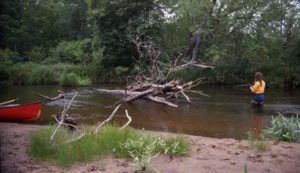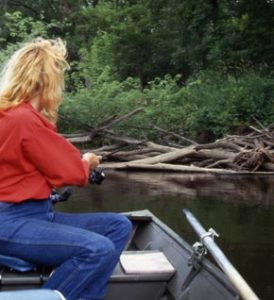Rocks and smallmouth bass . . . they go together like lily pads and bluegills, right? Not necessarily. While rivers generally need lots of rock to have high numbers of smallies, river sections with only a little rock can have more big smallmouth bass than many realize.
There are a couple key reasons why some waters that don’t fit the typical rocky river profile still harbor nice bronzebacks. In some regions, upper stream reaches have excellent habitat for reproduction and for high numbers of small bass, but are too shallow and fast flowing for big bass. Once smallmouth bass reach 13 to15 inches, many start drifting downstream looking for deeper, slower flowing, more favorable big-fish habitat.
And even if the lower reaches have little rock and considerable sand or silt, they can still support some hefty bass if they have deeper holes and good wood cover. And since, here, they seldom have to compete with high numbers of small bass, the big smallies have plenty to eat.

These waters don’t look like classic smallmouth bass habitat , so most
anglers bypass them, leaving the bronze boys for you
The second reason some “sand rivers” hold big smallmouth bass is because they’re so overlooked. These waters don’t look like classic smallmouth bass habitat and they require different techniques, so most anglers bypass them or just fish them for other species like catfish. Leaving the bronze boys for you.
Identifying Productive Sand Sections
- The river section should be connected to an upper river section or tributary that provides good reproductive conditions and habitat for small bass. Even river distances of 20 and 30 miles won’t stop the downstream movement of bass, if no large blocking dams are present.
- River depths should be sufficient to hold big bass. These deep water areas don’t have to be widespread; even a river with only two or three deeper outside bends per mile can hold some good fish. In low visibility rivers, water 4 or 5 feet deep can hold big smallmouth bass. In clear rivers, 5- to 7-foot depths are better.
- River sections with wood cover are much better than those without it. Trees, logs or brush in several feet of water offer big bronzebacks prime feeding and hiding areas. In rivers with lots of open pools and also wood cover, most of the biggest fish will be in the timber.
Sand River Tactics
Naturally, the best way to fish a substantial stretch of river is to float it. And your first trip on a sand river should be regarded as an exploratory one. Besides fishing as many different spots as possible, pay careful attention to depths, current and amount and type of cover. And besides just marking likely spots on a map or GPS unit, record in a notebook or pocket recorder the type of water you found. All of this information will be extremely helpful on future trips.

Target the largest wood cover in the deepest water
The best way to start fishing an unfamiliar sand river is to target the largest wood cover in the deepest water. Depending on the river, the best cover may be a large logjam in 10 feet of water, or only small logs 4 feet deep. Unless a log or tree trunk is thick enough (two feet in diameter) to act as a good current buffer, most fish will avoid wood that is lying in strong current. Some of the best cover is wood lying in slow water, but near moderate current. Even wood in completely slack backwaters or side channels will attract smallmouth bass, if little other cover is available in the main channel and if largemouth bass aren’t common.
Careful boat positioning is necessary to effectively fish river wood. For most situations, anchoring is best. If the cover is a large tree or thick jam in at least 5 feet of water, you can tie up directly to the wood. Try to make as little noise as possible. If you bang into the logs and alarm the fish, give them 10 minutes to resume feeding.
Wood and Vertical Jigging
Vertical fishing is an effective method to work a big jam. You’ll need heavier tackle for this than for open water fishing. A medium-power rod and 12-pound-test line will allow you to wrestle hefty bronzebacks out of cover. A Texas-rigged or snag-guard-equipped jig dressed with a scented 3-inch grub or tube is good for vertical fishing in wood. And make sure the weed guard isn’t too stiff; I think it’s better to lose a few lures than to miss lots of strikes due to a stiff guard.
Pay close attention to light strikes, as the lure makes its initial drop and while jigging. Smallmouth bass inhaling the jig as it falls is particularly common in logjams. For sluggish bass, working the lure in place by slowing raising and lowering it about 4 inches off the bottom produces strikes when nothing else will. The best jig colors will vary by season and water clarity, but bright combinations of white, chartreuse and yellow in the spring are good. In the summer and fall I use more subdued hues such pumpkinseed, black and smoke in summer.
No question, you’ll seldom catch high numbers smallies in sand rivers. But if you’re interested in overlooked waters with the potential to hook some real rod benders, these may be just the places to try.


No comments yet.